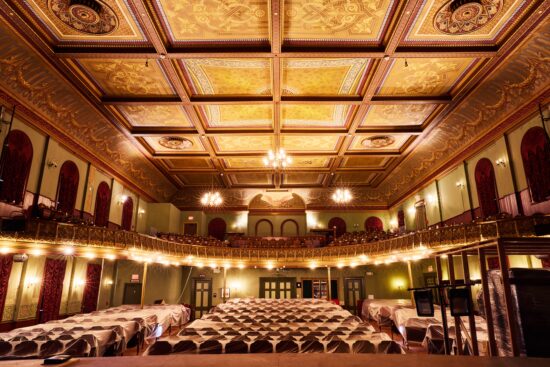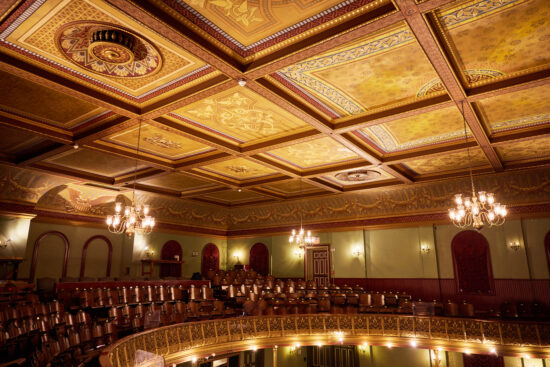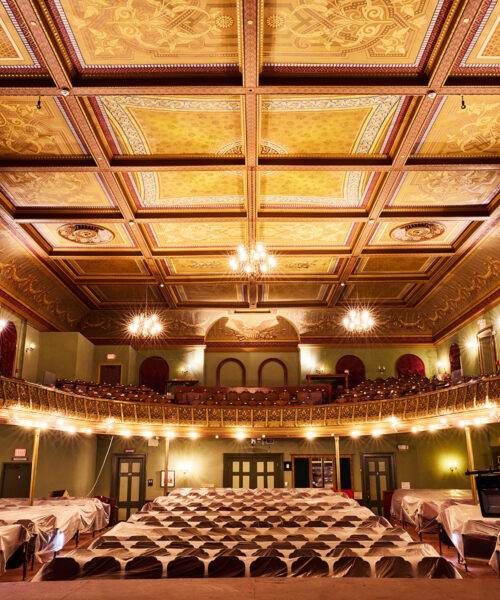January 23, 2025
High and Mighty
Restoration of historic theater goes above and beyond
By Troy McMullen
Photos by Ryan Lavine
The elaborate dry fresco paintings that cover the ceiling of the Thomaston Opera House date back to 1884, when the Romanesque building was erected as a venue for theatrical performances and social events in Litchfield County.
The hand-painted panels were created in the Eastlake Victorian style, with more than 180 colors used to produce the intricate geometric shapes and other stenciled motifs that adorn the coffered ceiling. The illustrations have long been a treasured attraction for visitors to a landmark venue that still ranks as the county’s oldest and largest theater.
After years of neglect, though, the ceiling eventually fell into disrepair, with decades of dust, grime, and water damage obscuring the original colors and details. Now, some 140 years after its creation, the opera house is unveiling a $3.5 million facelift that includes bringing its original ceiling artwork back to life.

“It’s a point of pride for this community,” says Jeff Dunn, executive director of Landmark Community Theatre, a nonprofit arts organization that operates the opera house. “Restoring the original artwork in the building, especially the ceiling, was really a priority when we began this project.”
The yearlong renovations were spearheaded by Thomaston Selectman Mike Burr. who is the chairman of the Opera House Commission. Working with fundraising group Friends of the Thomaston Opera House, Dunn managed the capital campaign for the project through grants, solicitations, and events. More than $400,000 was raised for the first phase of the project, with another $2 million secured from the state’s Community Investment Fund.
The renovation includes much-needed structural, mechanical, and electrical upgrades, including adding a new stage-accessible elevator, expanded handicap access, and renovated dressing rooms.
But restoring the ceiling to its former glory was the jewel of the project.
“Part of the draw to this building, along with the performances, is just the historic nature of the venue,” says Dunn, a Thomaston native who has been managing the opera house for nearly 30 years.
EverGreene Architectural Arts led the refurbishment. The Brooklyn-based firm has restored hundreds of historic properties around the country, including 41/50 of state capitol buildings.
Workers spent months cleaning the more than 30 ceiling panels with specialty materials applied by hand that wouldn’t harm the original paint, says EverGreene founder Jeff Greene. They also cleaned and restored the coves between the ceiling and walls and the stenciled wooden beams between the ceiling panels.

Once decades of old overpaint were removed, workers discovered the ceiling’s original 1884 artwork virtually intact, including the allegorical trompe l’oeil coffers representing the four cornerstones of the opera house’s mission: drama, architecture, music, and education.
“That’s extremely rare in a building this old,” says Greene. “It was almost the pristine original once the debris was wiped away.”
Dunn says the restoration is more than just a vanity project.
“The theater is an important piece of Thomaston’s history,” he says. “So we’re restoring a living, breathing part of this community.” —landmarkcommunitytheatre.org






















